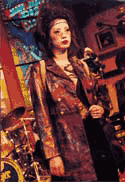Back when the Comrade was a Hong Wei Bing (Red Guard), we all wore
the same junzhuang (Mao suit) and hat with the little red star on it.
The weiyide (singular) faxing (hairstyle) for both men and women was
'bed-head.’ And we didn’t have expensive yangjiu (foreign booze) like
"X. O." in which to drown our sorrows. Everyone had to queue up at the
local still to get a paltry share of homemade baijiu(moonshine).

But shimao (fashions) and chaoliu (trends) have changed, big-time.
These days it’s not uncommon to see young men dressed like heishoudang
(gangsters) and women dressed like Julia Roberts in Pretty Woman. Some
of them are so scantily clad you’d think there was a fabric shortage.
If the Chairman were around today to see what’s chixiang (in vogue)
among the masses, he’d burst his wart.
In the spirit of shishi qiushi (Seeking Truth From Facts) and in order
to ganshimao (keep in style), the Comrade has analyzed modeng ("modern")
Chinese fashion phenomena and determined the major factors (besides
inherent bad taste) negatively influencing fashion in China today.
First, due credit must be given to Xiaoping tongzhide (Comrade Deng
Xiaoping’s) Jingji Gaige Kaifang (Economic Reform and Opening), for
making it possible for China to even have such a thing as "fashion"
in the first place. Before the 1980s reforms, men and women all wore
the same unisex blue or gray outfit. Since China dakaiguomen (opened
its doors to the world), women who had been dressing like men all their
lives were suddenly free to huazhuang (put on makeup) and show their
legs in public. Hence the present-day over-zealousness to do so.
Reform and Opening has made it possible for almost every Chinese family
to have access to a color television. And there’s no doubt that the
most influential force affecting fashion in China today is TV and movies.
Chinese youth are as likely to imitate the way actors and actresses
dress as waidi mingong (migrant workers from the countryside) are likely
to squat in the street, stare at foreigners, and wabizi (pick their
nose).
Thanks to Hong Kong and Taiwan numingxing (TV and movie actresses) for
popularizing the "Julia Roberts" look, characterized by rantoufa (lit.
"polluted" or colored hair), gaogenrxie (high-heels) or pixue (leather
boots), a tight miniqun (miniskirt) and caked-on cosmetics. Some of
them wear so much makeup that the Comrade doesn’t know if he’s looking
at a woman’s face or a houpigu (monkey’s behind).
But many Chinese women still opt for the more baoshou (conservative)
"Scarlet O’Hara" look, characterized by a frilly hat, white gloves,
and a flowing, ankle-length dress tied with an obtrusive bow. Optional
"Scarlet O’Hara" apparel includes xiutao (lit. "sleeve sheaths" i.e.
those white sleeve covers store clerks wear that sometimes go as high
as the shoulder) and a yangsan (umbrella) for good measure - note the
character yang (sun), rather than yu (rain) - implying that Chinese
umbrellas serve the dual purpose of blocking the rain and the sun. This
quanfu wuzhuang (complete suit of armor for protection) is intended
for the explicit purpose of keeping the sun’s blackening rays from touching
any part of the body (heaven forbid!). For it is still as liuxing (fashionable)
as ever in China to have nen (soft), milky white skin, indicating that
you’ve never toiled a day in your life (i.e. you’re not a peasant farmer).
One of the more guofen (over-the-top) fashion practices gaining popularity
in the PRC’s metropolises is meirongshoushu (cosmetic surgery). A simple
operation can make those "long" eyes "round", that "short" nose "tall",
or turn those darn danyanpi ("single" eyelids) into shuangyanpi ("double"
eyelids) with a single slice of the knife.
But regardless how many Chinese opt to bedeck themselves with the most
shixing (hip) western fashions, the requisite garb of the average Chinese
laobaixing (common folk) is still as ubiquitous as ever.
For men, there’s the standard-issue dust-gray suit pants and jacket
(don’t forget to leave the label on the sleeve!), white dress shirt
and metallic silk tie, white gym socks, black pleather (plastic-leather)
loafers and a trusty pleather handbag to carry mobile phone, beeper,
cigarettes and wads of cash. Adorn yourself with as much jewelry as
possible. In the winter, a set of pastel-colored long underwear and
pleather coat with maoling (fur collar) is optional.
Typical women’s fashions include knee-high pleather boots, manila envelope-colored
stockings (worn over optional knitted wool leg warmers), a wool skirt,
knitted wool sweater and long, mauve-colored pleather coat with fur
collar. And you can never wear too much jewelry! Hair extensions are
optional.
Finally, there are the unisex Chinese fashions that will probably never
guoshile (become outdated; go out of style). These include the kouzhao
(face mask), wearing your shuiyi (pajamas) to the market, and T-shirts
with anything in English written (or better yet misspelled) on them.
Keep the above fashion rules in mind when planning your next social
engagement, and you won’t make a shamao’r (fool) of yourself.







